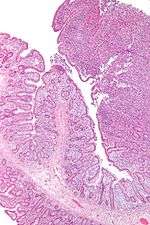T-cell lymphoma
T-cell lymphomas are lymphomas that affect T cells. There are four major types, and they account for about one in ten cases of non-Hodgkin lymphoma.[1]
| T-cell lymphoma | |
|---|---|
 | |
| Micrograph of an enteropathy-associated T-cell lymphoma (upper right of image), a type of T-cell lymphoma. H&E stain. | |
| Specialty | Hematology and oncology |
They can be associated with Epstein Barr virus and Human T-cell leukemia virus-1.[2]
Types
The four classes are:
- Extranodal T cell lymphoma
- Cutaneous T cell lymphomas: Sézary syndrome and Mycosis fungoides
- Anaplastic large cell lymphoma
- Angioimmunoblastic T-cell lymphoma
More information on various classification schemes is in the main lymphoma article.
Diagnosis
Treatment
Epidemiology
Of all cancers involving the same class of blood cell, 8% of cases are mature T cell lymphomas.[3] Of such cases, 2% are precursor T lymphoblastic and 2% are cutaneous T cell lymphomas.[3]
See also
References
- "The Lymphomas" (PDF). The Leukemia & Lymphoma Society. May 2006. p. 2. Archived from the original (PDF) on 2008-07-06. Retrieved 2008-04-07.
- Vose JM (October 2008). "Peripheral T-cell non-Hodgkin's lymphoma". Hematol. Oncol. Clin. North Am. 22 (5): 997–1005, x. doi:10.1016/j.hoc.2008.07.010. PMID 18954748.
- Turgeon, Mary Louise (2005). Clinical hematology: theory and procedures. Hagerstown, MD: Lippincott Williams & Wilkins. p. 283. ISBN 0-7817-5007-5.
Frequency of lymphoid neoplasms. (Source: Modified from WHO Blue Book on Tumour of Hematopoietic and Lymphoid Tissues. 2001, p. 2001.)
This article is issued from
Wikipedia.
The text is licensed under Creative
Commons - Attribution - Sharealike.
Additional terms may apply for the media files.